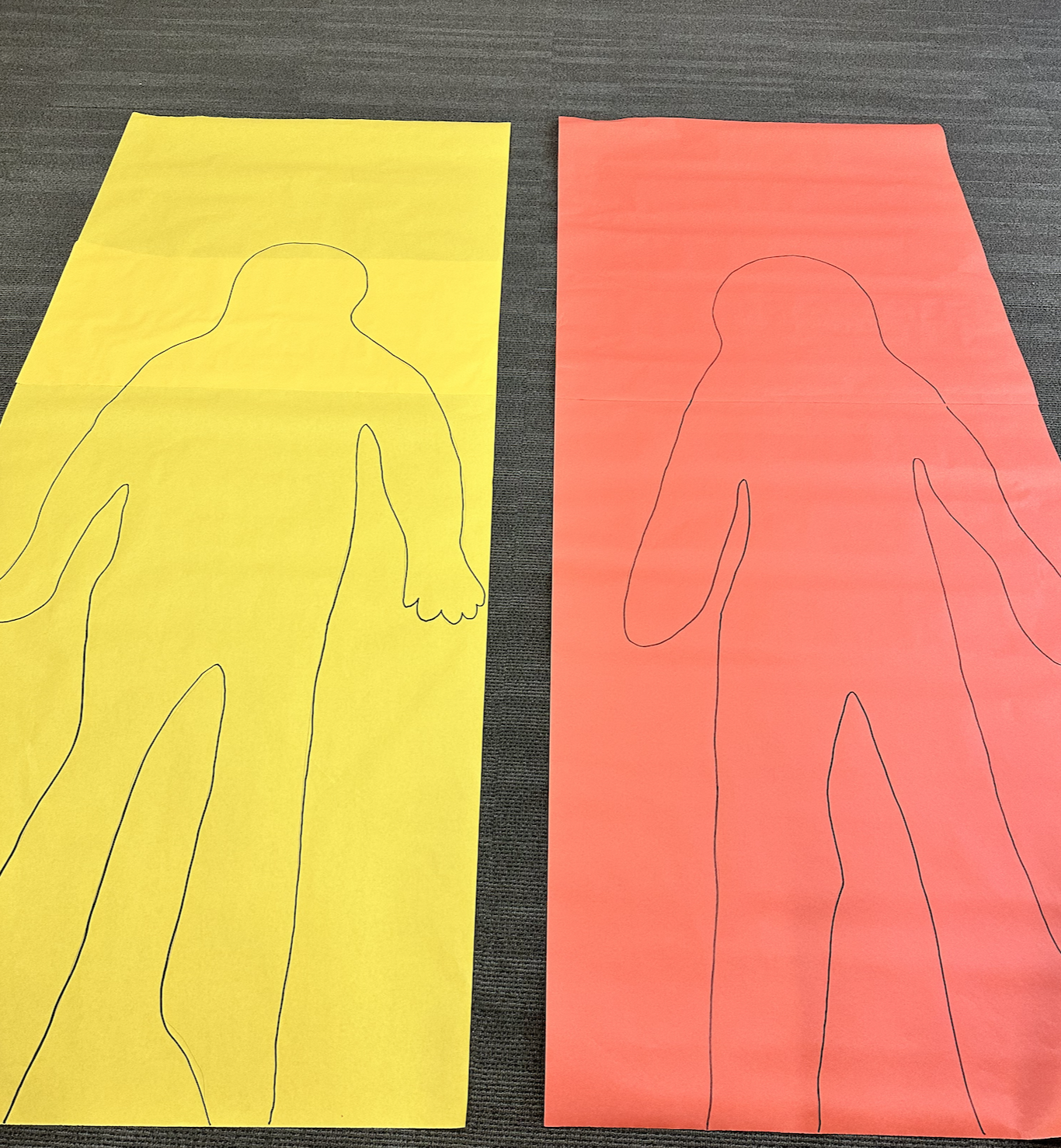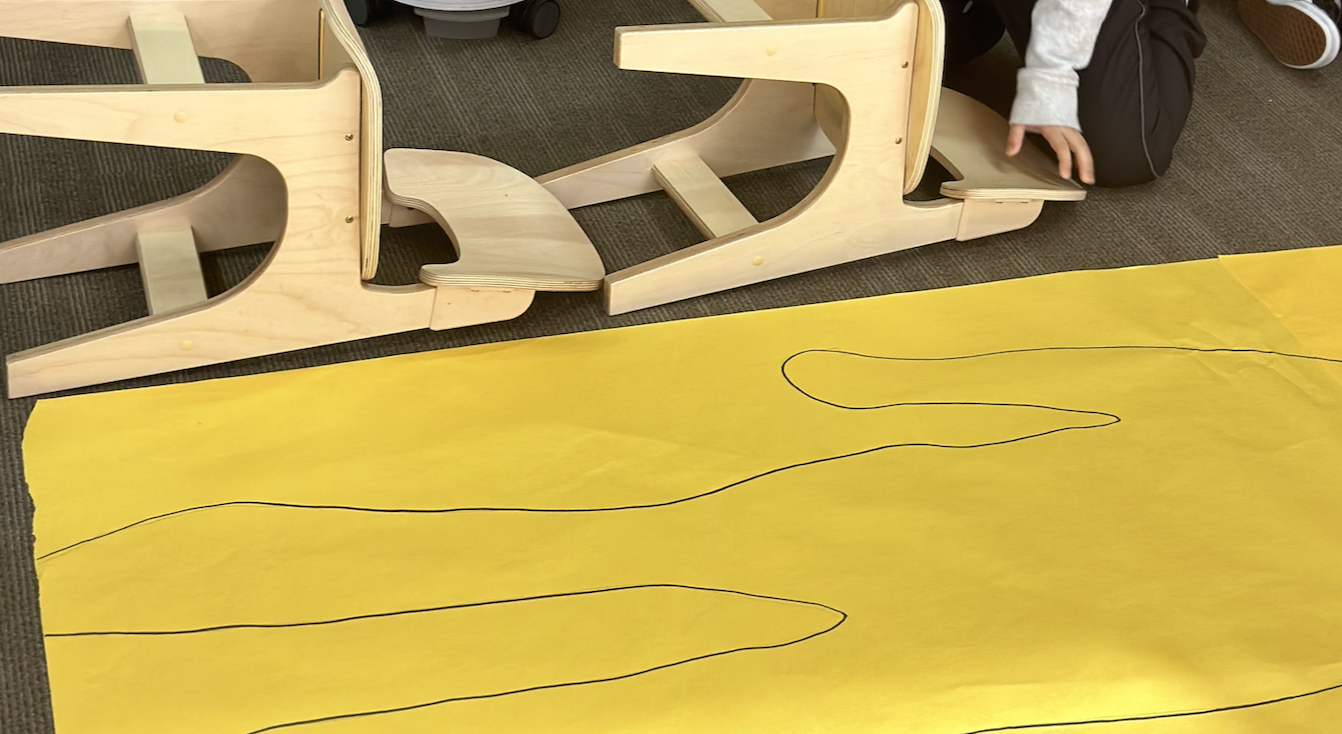Teaching Journey & Lesson Plan
The Story: Measuring the Mystery Bodies
One day, my co-teacher and I set up a scene in the classroom with two large body outlines on the floor. The outlines immediately sparked curiosity among the students, who began asking questions like, “Whose bodies are these?” and “Why are they on the floor?” This setup naturally led to discussions about the size of the bodies as students started comparing their lengths and widths. To channel their curiosity into a learning opportunity, we encouraged them to guess whose bodies the outlines might represent. When asked what we should do first to solve the mystery, the students eagerly suggested, “We need to measure!”
Their enthusiasm prompted a rich discussion about how we could measure the bodies and what tools to use. The students brainstormed ideas, such as cubes, rulers, and books. Through their experimentation with non-standard measurements, they discovered that the tools needed to be consistent in size, large enough to cover the body outlines, and easy to use. Working in small groups, they measured the body outlines using clipboards, papers, books, and even chairs. Eventually, the students measured their teachers’ bodies and compared them to the outlines on the floor to confirm the match.
This engaging and playful activity not only solved the mystery of the body outlines but also encouraged students to create their own stories about why the drawings were there, sparking creativity and imagination.



The Lesson Plan: Measuring the Mystery Bodies
The Lesson Plan: Measuring the Mystery Bodies
Target Age Range:
This lesson is ideal for children aged 3 to 8, with adaptations for developmental levels and group sizes.
Concepts:
Measurement
Non-Standard Units
Problem-Solving
Objectives:
To introduce students to the concept of measurement using non-standard units.
To foster reasoning, collaboration, and critical thinking.
To connect mathematical concepts to engaging, real-world scenarios.
Materials Needed:
Two large body outlines on the floor (made with butcher paper or chalk)
Non-standard measuring tools (e.g., books, papers, clipboards, chairs, cubes)
Rulers or measuring tapes (optional for an extension activity)
Steps:
Set the Scene:
Arrange two large body outlines on the floor before students arrive.
Allow students to discover the setup naturally and share their observations and questions.
Prompt discussion: “Whose bodies do you think these are? How can we find out?”
Discuss Measurement Tools:
Ask students what tools they could use to measure the bodies. Write down their suggestions on the board.
Discuss what makes a good measuring tool: consistency in size, ease of use, and appropriateness for the task.
Small Group Measurement Activity:
Divide students into small groups and assign each group a different measuring tool (e.g., books, papers, clipboards, chairs).
Have students measure the body outlines using their assigned tools and record their results.
Compare and Reflect:
Bring the class together to share their measurements and discuss their experiences.
Ask reflective questions:
“Were your measurements the same as another group’s? Why or why not?”
“Which tools were easiest to use? Why?”
Solve the Mystery:
Measure the teachers’ bodies using the same tools and compare them to the outlines.
Celebrate solving the mystery and invite students to share creative stories about why the outlines were there.
Extend the Activity (Optional):
Introduce rulers or measuring tapes and compare the results with the non-standard measurements.
Discuss why standard units of measurement might be more useful in some cases.
Why This Supports Students’ Thinking and Conceptual Understanding
Developing Measurement Concepts:
This lesson introduces foundational measurement skills in a hands-on and exploratory way. By using non-standard units, students learn about length, comparison, and consistency, which prepares them for transitioning to formal measurement systems.
Encouraging Problem-Solving and Critical Thinking:
Students explore different tools and strategies, fostering creativity and critical thinking. They evaluate their tools' effectiveness and refine their approaches based on observations.
Connecting Math to Real-Life Scenarios:
The story of the body outlines contextualizes measurement in a meaningful and relatable way. Students see math as a practical tool for solving mysteries and answering questions.
Building Collaboration and Communication Skills:
Small group work encourages teamwork and verbal communication. Students share their methods, listen to others, and collaboratively solve problems, strengthening social and mathematical learning.
Gradual Introduction to Standard Measurement:
The activity bridges non-standard and standard measurement, helping students understand the importance of consistency. This progression supports their conceptual development and readiness for formal math learning.
By combining curiosity, play, and collaboration, this lesson transforms the abstract concept of measurement into an engaging and accessible experience for young learners.
